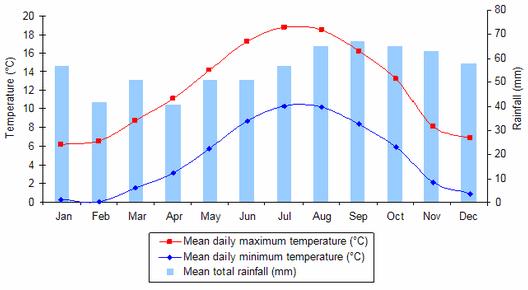The climate of Australia is often simplistically associated with sun-drenched beaches, vibrant barbecues, and outdoor festivities. However, such a narrow interpretation fails to encapsulate the extraordinary climatic diversity across this vast continent. The Australian climate is a complex tapestry woven from numerous climatic zones, each contributing uniquely to the continent’s environmental fabric. This article endeavors to elucidate the multifaceted nature of Australia’s climate, underscoring the stark contrasts that exist within its boundaries.
At the forefront of the Australian climatic landscape lies the arid zone, which predominates across the vast interior. This region, often referred to as the Outback, accounts for nearly 70% of the Australian continent. Here, one encounters extreme temperatures, with scorching heat during the day and considerably cooler nights. Rainfall is infrequent and sporadic, leading to a landscape characterized by red deserts, sparse vegetation, and resilient flora and fauna adapted to thrive in such inhospitable conditions. The common perception of Australia as a land of perpetual sunshine often overlooks the harsh realities faced by the ecosystems in this region, which require profound adaptation mechanisms to survive.
Moving towards the northern stretches of Australia reveals the tropics, where a vastly different climatic experience awaits. This region is marked by a tropical climate, epitomized by high humidity, copious rainfall in the wet season, and oppressive heat. Here, life springs forth with vigor; lush rainforests flourish, teeming with biodiversity. However, the tropical climate is not without its perils. It also brings about the threat of cyclones, which wreak havoc and disruption annually, demonstrating how climate and environmental phenomena are interlinked in the tropics of Australia.
The coastal areas, synonymous with leisure and recreation, boast a temperate climate, characterized by moderate temperatures and relatively stable weather patterns. Coastal city dwellers enjoy a more forgiving environment, where mild winters and warm summers contribute to the overall allure of the shoreline. Nevertheless, the proximity to the ocean brings forth its challenges; rising sea levels and the increasing frequency of extreme weather events loom as pertinent threats. Thus, even in the idyllic coastal regions, the ramifications of climate change manifest strikingly, prompting a re-evaluation of how these communities relate to their environments.
Australia’s temperate climate is not stagnant; rather, it exhibits seasonal variations, significantly influenced by factors such as latitude and geography. The southernmost regions, particularly Tasmania, encounter a more maritime climate, where cool temperatures alleviate the scorching heat commonly felt elsewhere. Consequently, Tasmania stands as a remarkable biodiversity hotspot, showcasing a distinct array of ecosystems thriving in cooler temperatures. The stark climatic distinctions across the southern regions lay bare Australia’s ecological wealth and highlight the need for diligent conservation efforts.
It is essential to delve into the implications of such climatic variation on both the environment and the economy. Agriculture, one of the backbone industries of Australia, is profoundly impacted by climate conditions. The diverse climates allow for a variety of agricultural practices, from viticulture in South Australia to cattle ranching in the northern territories. However, the unpredictability of climate phenomena, such as droughts or floods, poses severe risks to these agricultural systems. The direct correlation between climate variability and food security cannot be overstated, necessitating a rethinking of sustainable practices that empower farmers to adapt and thrive.
Moreover, an examination of indigenous knowledge presents a valuable perspective in understanding Australia’s climate. Indigenous communities have long recognized the significance of ecologically sustainable practices and their reliance on the land. Traditional ecological knowledge offers insights into understanding seasonal changes, weather patterns, and biodiversity conservation. The integration of such knowledge into contemporary environmental management presents an opportunity to enhance resilience against climate change impacts, granting native practices a rightful place in modern discussions surrounding climate adaptation strategies.
Climate change, a pressing global issue, has ignited discourse regarding Australia’s future ecological stability. Rising temperatures, prolonged droughts, and changing precipitation patterns have already begun to alter ecosystems, prompting concerns over species extinction and habitat loss. The Great Barrier Reef, a UNESCO World Heritage Site, faces an existential crisis due to coral bleaching exacerbated by rising ocean temperatures. This vivid illustration of climate impact serves as a clarion call for urgent action, highlighting the necessity for robust policies that address climate change on both domestic and international fronts.
In summation, Australia’s climate extends far beyond the sun-soaked beaches and sizzling barbecues popularized in media portrayals. It is a realm of stark contrasts and extreme conditions, bounded by the interplay of environmental phenomena. Understanding this intricate climate narrative is vital not only for appreciating Australia’s unique landscapes and ecosystems but also for informing policy-making, promoting sustainable practices, and fostering resilience against climate change impacts. The urgency to preserve and protect Australia’s diverse climates is paramount, as they serve as linchpins for ecological balance, human survival, and the rich tapestry of life that calls this extraordinary continent home.







